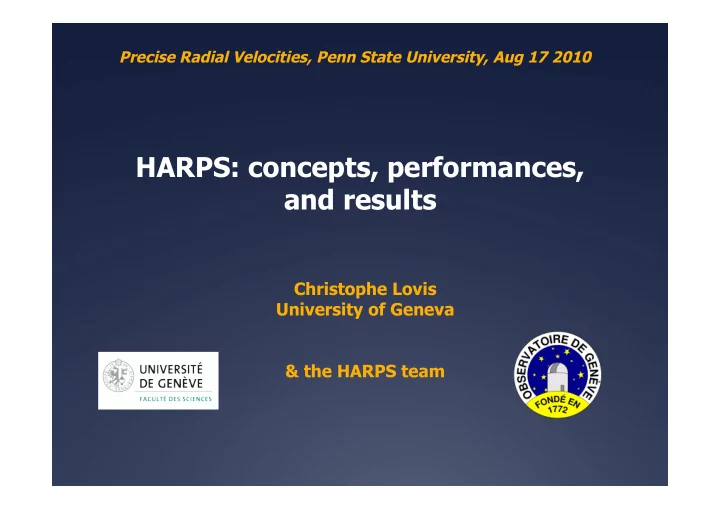

Precise Radial Velocities, Penn State University, Aug 17 2010 HARPS: concepts, performances, and results Christophe Lovis University of Geneva & the HARPS team
Outline The simultaneous reference technique HARPS instrumental performances Some recent results on low-mass planets High-precision spectroscopy Long-term results on a quiet star
Instrumental challenges to astronomical high-precision « line position » measurements Slit illumination: • 1/100 of the slit width <-> 30 m/s @ R = 100,000 Variations in the index of refraction of air: • 1 m/s <-> 0.01 K <-> 0.01 mbar Thermal and mechanical flexures in the spectrograph: • ~10-100 m/s (temperature, gravity, setup changes) Wavelength calibration • High line density, high repeatability/accuracy, good modeling/fitting Detector-related effects • Pixel inhomogeneities, CTE effects, flat-fielding, etc.
« Simultaneous reference » philosophy: address individual effects and minimize them Slit illumination Light feed / guiding • Variations in the index of refraction of air Spectrograph • Thermal and mechanical flexures • Wavelength calibration Calibration source • Detector-related effects CCD •
Slit illumination Guiding error: 0.5’’ → 2-3 m/s for a HARPS-like spectrograph Fiber-fed spectrograph Fiber entrance Image scrambler Fiber exit RV
Simultaneous ThAr reference Assumption: science and reference beams follow almost the same path from the slit to the detector, and will thus experience the same internal drifts Object � ThAr �
Object ThAr spectrum spectrum Wavelength calibration frame 0 RV Object fiber ThAr reference RV 0
Object spectrum ThAr spectrum Science exposure RV (object) = RV (measured) - RV(drift) 0 RV (measured) RV Object fiber ThAr reference RV 0 RV(drift)
Minimization of internal effects in the spectrograph Δ RV =1 m/s � Δ RV =1 m/s � Δλ =0.00001 A � Δ T =0.01 K � 15 nm � Δ p=0.01 mbar � 1/1000 pixel � Vacuum operation � Temperature control �
Extraction of the RV information cross-correlation mask 1.2 1 0.8 0.6 0.4 CCF (v R ) 0.2 0 -80 -60 -40 -20 0 20 40 60 80 RV [km/s] RV ∑ ∫ CCF (v R ) = M ( λ ,v R ) ⋅ I ( λ ), where M ( λ ) = ( λ − λ i ) ⋅ w i θ i λ i
The HARPS instrument and the quest for low-mass planets ESO-3.6m @ La Silla • Cross-dispersed echelle spectrograph • Spectral range 3785-6915 Å • R = 115,000 • Long-term precision < 1 m/s • Observations ongoing since 2003 HARPS
Absolute position of one single ThAr line on CCD Line position on CCD [pixels] rms (30 days): 0.0014 pixel ⇔ 21 nm ⇔ 1.1 m/s Line position on CCD [m/s] No drift correction !
Wavelength calibration High stability of the wavelength solutions, locally precise to 2-3 m s -1 Precision on the global radial velocity zero point: ~30 cm s -1
Intrinsic line shifts in ThAr lamps • Lamp aging -> pressure shifts • Avoid Argon! • Global Ar-to-Th sensitivity ratio: ~8.3 • Zero point correction using measured Ar line positions!
HD 40307: three close-in super-Earths rms = 0.85 m/s Mayor et al. 2009
Gliese 581: super-Earths close to the habitable zone ? Gl 581 b Gl 581 c Gl 581 d P = 5.37 days P = 12.9 days P = 66.8 days K = 12.5 m s -1 K = 3.24 m s -1 K = 2.63 m s -1 m sin(i) = 15.7 M ⊕ m sin(i) = 5.36 M ⊕ m sin(i) = 7.1 M ⊕ Gl 581 e P = 3.15 days K = 1.85 m s -1 m sin(i) = 1.94 M ⊕ Bonfils et al. 2005 Udry et al. 2007 Mayor et al. 2009
Global RV dispersion • Peak at ~1.3 m/s • Many stars ARE as quiet as this! Distribution of RV dispersion etc • All simulations of stellar noise should be compared to that • Raw rms! • Includes photon noise, instrumental noise, stellar noise and planets • Many candidate planet-hosts have rms of 1-3 m/s • This is still significantly better than other instruments…
CoRoT-7b: the first transiting super-Earth CoRoT lightcurve, Léger et al. 2009 CoRoT-7 SpT = G9V V = 11.7 M * = 0.93 M ☉ Teff = 5275 K log(R’ HK ) = -4.60 Active star! CoRoT-7b CoRoT-7c P = 0.85 day P = 3.69 days R p = 1.7 R ⊕ R p = ? M p = 4.8 M ⊕ M p = 8.4 M ⊕ ρ = 5.6 g cm -3 ρ = ? HARPS RVs, Queloz et al. 2009
GJ 1214 b: a super-Earth around a M4.5 dwarf Charbonneau et al. 2009 HARPS RVs MEarth lightcurve GJ 1214 GJ 1214 b SpT = M4.5V P = 1.58 day V = 15 R p = 2.68 R ⊕ M * = 0.16 M ☉ M p = 6.55 M ⊕ rms = 5.2 m/s despite V=15, SNR=9, 3.6m Teff = 3000 K ρ = 1.9 g cm -3 aperture, non-optimal correlation mask…
High-precision spectroscopy • High stability yields high-precision RVs, but also very good spectroscopy in general • Benefits to any line position measurement, equivalent widths, line shapes • Spectrophotometry and spectroscopic indicators very useful diagnostics in the context of planet searches • Ca II H&K index, CCF FWHM and contrast, bisectors • What is the behavior of solar-type stars at this level of precision?
High-precision spectroscopy rms = 1.70 m/s rms = 8.49 m/s rms = 1.48 m/s rms = 0.019 dex
High-precision spectroscopy Activity – rotation relation (Noyes et al. 1984, Mamajek & Hillenbrand 2008) gives P rot = 40.9 +/- 5.6 d Measured: either 35 or 46 d
High-precision spectroscopy
Recommend
More recommend